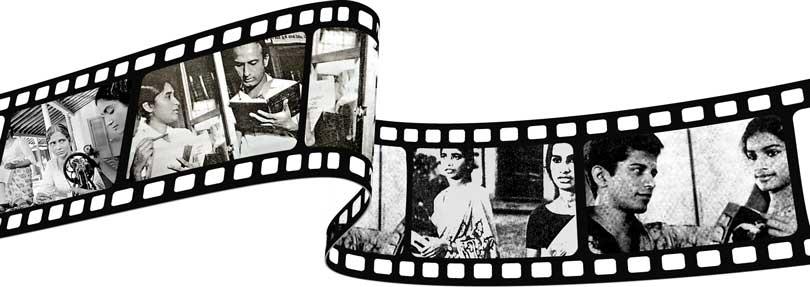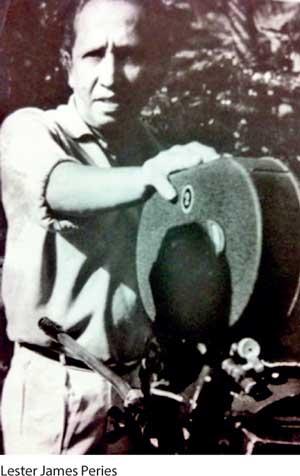Reply To:
Name - Reply Comment

 By the time Vijaya Kumaratunga played the lead role in Hanthane Kathawa, Gamini Fonseka had acted in over 20 films, consolidating his box office drawing power. The year was 1969, which, I rather feel, was to the Sinhala cinema what 1967 had been to the American: one that redefined an entire industry. Many, if not most, of the films that came out of Hollywood in that year were groundbreaking: Bonnie and Clyde, In the Heat of theNight, Cool Hand Luke, The Graduate, Guess Who’s Coming to Dinner?, and the first Asian outing for James Bond, You Only Live Twice. The message was clear enough: the American cinema had been reborn, through the independent movement and the influence of European directors. These movies shared nothing in common with each other, except their rejection of what had been taken as the norm in Western movies: studio lit, box office led.
By the time Vijaya Kumaratunga played the lead role in Hanthane Kathawa, Gamini Fonseka had acted in over 20 films, consolidating his box office drawing power. The year was 1969, which, I rather feel, was to the Sinhala cinema what 1967 had been to the American: one that redefined an entire industry. Many, if not most, of the films that came out of Hollywood in that year were groundbreaking: Bonnie and Clyde, In the Heat of theNight, Cool Hand Luke, The Graduate, Guess Who’s Coming to Dinner?, and the first Asian outing for James Bond, You Only Live Twice. The message was clear enough: the American cinema had been reborn, through the independent movement and the influence of European directors. These movies shared nothing in common with each other, except their rejection of what had been taken as the norm in Western movies: studio lit, box office led.
What did 1969 mean for the Sinhala cinema then? It represented the climax of what Lester James Peries had begun with Rekhawa in 1956. I say this for two reasons. Firstly Lester, in the year the SLFP-MEP won, had emancipated the Sinhala cinema from what the late L. O. Silva referred to as the Sinhala cinema’s parents, “the Tower Hall stage and the South Indian film.” Shot in the great outdoors, with the most rudimentary setup more befitting of a documentary than a feature film, Rekhawa indicated, for the first time, the depths to which the local cinema could go in search of authenticity; at the same time, however, Peries and his crew were forced to give way to much of what had characterised Sinhala films until then: histrionic dialogues, larger-than-life caricatured antagonists (Romulus Perera, who played the role of the scheming mudalali, was a popular Tower Hall actor), and the theme of good triumphing over evil. In defying the conventional cinema, Lester had partially entrenched himself in it.
We see the person who freed the Sinhala movie from the theatre in 1956 freeing it fully from all theatrical constraints in his third film, Gamperaliya, in 1963
 We see the person who freed the Sinhala movie from the theatre in 1956 freeing it fully from all theatrical constraints in his third film, Gamperaliya, in 1963. Between these two years, the social-cultural-political matrix that had made Rekhawa possible had made Gamperaliya more than merely possible: indeed, contrary to what Ediriweera Sarachchandra noted in his review, Lester’s adaptation of Martin Wickramasinghe’s landmark novel was not an “opa pathika” or immaculately conceived work of art without any precedent, but was instead a work evidently informed by the social, cultural, and political landscape against which it had been made. In the early days, theatre had been a petty bourgeois affair; by this I am referring to the Sinhala hybrid theatre, the kind pioneered by Charles Dias and John de Silva and reworked later by Sirisena Wimalaweera. The upper class ignored and laughed at these plays; later, in the same vein, they would laugh at Romulus Perera’s acting in Rekhawa.
We see the person who freed the Sinhala movie from the theatre in 1956 freeing it fully from all theatrical constraints in his third film, Gamperaliya, in 1963. Between these two years, the social-cultural-political matrix that had made Rekhawa possible had made Gamperaliya more than merely possible: indeed, contrary to what Ediriweera Sarachchandra noted in his review, Lester’s adaptation of Martin Wickramasinghe’s landmark novel was not an “opa pathika” or immaculately conceived work of art without any precedent, but was instead a work evidently informed by the social, cultural, and political landscape against which it had been made. In the early days, theatre had been a petty bourgeois affair; by this I am referring to the Sinhala hybrid theatre, the kind pioneered by Charles Dias and John de Silva and reworked later by Sirisena Wimalaweera. The upper class ignored and laughed at these plays; later, in the same vein, they would laugh at Romulus Perera’s acting in Rekhawa.
“They all laughed at all the wrong places,” Lester remembered of the night they first screened Rekawa. The reason why they did so, and why this was not a phenomenon specific or unique to Sri Lanka – throughout much of the postcolonial world, urban English-speaking elites remained for the most contemptuous of local culture – is that although most pioneering artists came from their colonised milieu, linguistic and cultural barriers hindered English speaking audiences from transcending their snobbish disregard for local work. It was not, as might be commonly assumed today, because they were more receptive to, say, English theatre, for the simple reason that they were not; critics from then have written of audiences coming from the Wendt arguing about the ending of a Pirandello play, or sitting through a Jean Anouilh play and “laughing at the wrong places.” It was a form of art not only uprooted from life, but also contradicted by the inability of actors and audiences to penetrate into it.
Hence Lester had to swim against two currents: not only the Westernised bourgeoisie, whose cultural experiences were far removed from their countrymen, but also the Sinhala and Tamil middle classes, whose interest was in seeing cheap fights, romances, and mysteries in films and plays. Ediriweera Sarachchandra revived the religious parable and allegory in Maname, and for a long time thereafter it remained a much resorted to motif in the Sinhala theatre that appealed to the middle classes. By contrast, Lester refused to give way to compromise; just a year after a detour with Sandeshaya, then, he made Gamperaliya – a work far removed from anything that had been made until then, including Maname and even Rekhawa.
At the same time, however, he was aware of the image he had created of himself among the middle class; thus it wasn’t the Anglicised Colombo crowd that made it possible for Lester to move on from Rekhawa, but a German actress who had been taken to watch it after asking her guide to take her to the theatre to a local film. Note the irony here: a tour guide, in Colombo, thinking of a person who had barely established himself in the local cinema when asked by a foreign lady to take her to see a “local film” (a category that in his mind would have excluded the Eddie Jayamanne-Rukmani Devi melodramas plus every other pseudo-local stories shot in India). Lester, in other words, had done what other filmmakers here hadn’t been able to: tap into the mood of the middle class without making too many compromises in their name. Regi Siriwardena described that aspect to him thus: “he has created the standard with which he is to be enjoyed.” No one, not even Pathiraja or Obeyesekere, could match him there. There’s a reason for that. Both Pathiraja and Obeysekere had Lester as a predecessor they could even choose to rebel against in later years. Lester, on the other hand, had no one.
All this, moreover, represents only one reason why, and how, Lester’s efforts “bore fruit” in 1969. There is a second reason, as important as if not more important than the first: the rise of a petty bourgeoisie which accepted Lester’s work for what it was. The petty bourgeoisie here differed little, if at all, from the petty bourgeoisie from other postcolonial societies: they were upward aspiring, they sold and spent everything to educate their children, and they held on to belief systems and cultural patterns rejected by the Westernised milieu. In Golu Hadawatha, Sugath and his brother own more than a hundred acres. There is no real social chasm between Sugath and Dammi that can explain their eventual separation: indeed they hail from the same milieu, which had by the time of Golu Hadawatha’s release given Lester some of his most loyal patrons. Vinod Moonesinghe described them well: “They may have owned a hundred or so acres, but the elite above them owned thousands and thousands more.”
These reflections take me back to where I began. 1969 meant many things to many filmgoers, and the movies that came out during the period were definitive of those many things: Lester’s Golu Hadawatha and Akkara Paha, G. D. L. Perera’s Romeo Juliet Kathawak and Dahasak Sithuvili, and perhaps the most undervalued of them, Sugathapala Senarath Yapa’s Hanthane Kathawa. That these were all love stories, and more to the point failed love stories, is, I think, more than a coincidence. They were all middle class as far as the milieus from which their characters emerge was concerned: from the hundred-acre-owning Sugath in Golu Hadawatha and the ambitious farmer who sends his son to a town school in Akkara Paha to the bantering campus students in Hanthane Kathawa. It’s also not a coincidence that Vijaya Kumaratunga should emerge at this juncture, and re-emerge as our last pre-television hero: pandering to more populist sentiments perhaps, yet hailing from an intermediate milieu.
Lester had to swim against two currents: not only the Westernised bourgeoisie, whose cultural experiences were far removed from their countrymen, but also the Sinhala and Tamil middle classes
Lester James Peries may not have consciously willed these changes, but he was at least partly responsible for them. In a critique of the Sinhala cinema, L. O. Silva observed that “an artist who wishes to communicate surrenders his freedom and the individuality of his authorship.” I remember the emotion with which I came away from Lester’s films, and I remember thinking how different they were to anything I had seen here. Lester had not sacrificed his originality, nor had he surrendered it for the need to communicate: L. O. was wrong. 1969, during which time he was making three films for the only producer that stayed with him for more than two, is thus the best possible evidence we have for the view that the cinema in countries like ours has to be guided by the individualistic impulses of an auteur.
A break was needed, and in this country the man on whom the task of making that break happen was Lester. 50 years ago, the break finally transpired. What happened in the decade following it is for a later essay. For now, let us be satisfied that it needed to happen, and that it did happen.